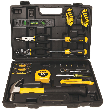Repairing wood siding on a home is a straight forward, relatively easy project. The only draw back is that it will usually require a lot of time and effort on your part. That being said, follow these straightforward instructions, and you should be able to have a newly restored wood siding, without having to go to the cost of replacing all of the siding in your home.
Materials needed:
- Putty knife
- Chisel
- Hand stapler
- Jigsaw
- Flat pry bar
- Hammer
- Shingle puller
- Hacksaw
- Circular saw
- Keyhole saw
- Building paper.
Procedure:
If at all possible, you should always begin repairing wood siding by fixing any holes while they are still small. By fixing the holes when they are small, you can prevent them from becoming larger. Start by first cutting out the small damaged area of the siding to ensure that you have removed all of the rotten wood. Fill the now smooth area with a putty knife and wood epoxy filler. Once that you have finished doing that, all that remains to do is sand the area smooth, prime it, then paint it to match the rest of your home. For larger areas, follow the steps detailed below.
- Drive spacers. In order to repair larger holes, and to prevent excessive damage to the rest of your siding, begin driving spacers into the areas around the damaged section of siding. These should be driven into the area between the damage, and the siding above it, in order to provide enough space for you to be able to remove the siding without damaging the older wood that surrounds it.
- Remove nails and siding. Use a flat pry bar, and a piece of scrap wood, to begin removing the nails that hold the damaged siding in place. Rest the pry bar against the scrap wood so that you avoid damaging the siding that doesn't need to be removed. Continue to remove these nails until you are able to remove all of the damaged siding.
- Replacement siding. Measure the area that used to have the siding, and leave 1/16 inch at each end (or a total of 1/8 inch) as an expansion gap. Wood will expand and contract with the weather and humidity, so this will allow your wood siding to do exactly that without causing any damage.
- Use old sidings as patterns. If the area that you are replacing had any cutouts or openings for spigots or outlets, you will need to cut those into your new siding. The easiest way to ensure that you get the right size and spacing for these is to use your old siding as a "template" pattern for that purpose. Make sure that you prime, seal, and paint the exposed areas before you install the new siding; just make sure that you allow everything to dry completely as well.
- Replace the building paper. Before you begin to install your new siding, make sure that you replace the building paper that was underneath the damaged siding. While you may only need to replace the paper that has been damaged, it is always better to replace it if it was under damaged siding. Simply cut the replacement piece so that it overlaps the damaged area, and then staple it in place.
- Install new siding. Nail your new siding into place. Start with the lowest point possible, and then work your way upwards. Follow the same nailing patter that exists on the remaining siding. Be sure that you also align the replacement siding with the existing siding as well.
- Prime and paint the siding. Replace any spigots, outlets, or other items that you may need to before you begin priming and painting your new siding. Once you have finished sealing, priming, and painting your siding, you have finished repairing the wood siding of your home.
Author Bio
Lee Wyatt
Contributor of numerous Tips.Net articles, Lee Wyatt is quickly becoming a regular "Jack of all trades." He is currently an independent contractor specializing in writing and editing. Contact him today for all of your writing and editing needs! Click here to contact. Learn more about Lee...
Air Purification Systems
One of the largest environmental factors in our health and comfort is the air we breathe. Air purification systems have a ...
Discover More
Importance of Space in Garden Design
If you are designing a garden, then you really need to understand how important space is. Frankly the importance of space ...
Discover More
Dog Ear Cleaning
Dog ear cleaning is an often overlooked portion of basic pet care, and sadly one that if not done regularly or properly, ...
Discover More
More Home Improvement Tips
Pouring a New Sidewalk
Over time, even the best laid sidewalks become a little damaged and need some repair. Unfortunately, there are going to ...
Discover More
Installing a Lamppost in Your Yard
Installing a lamppost in your yard can be a great idea for all kinds of reasons. While you can always hire someone to do ...
Discover More
Preventing Dry Rot
A rather common problem that faces many homes is that of dry rot. This insidious natural process can easily reduce the ...
Discover More

Comments